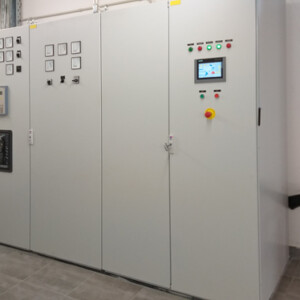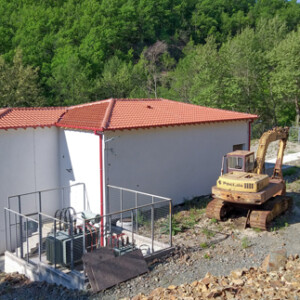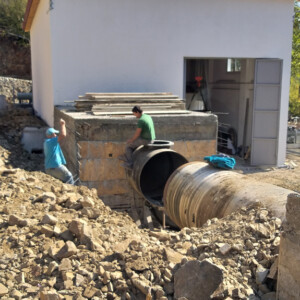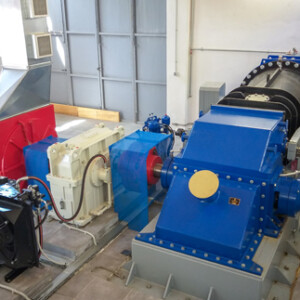A new crossflow turbine convinces all along the line in Greece
The new Skra power plant in the northern Greek province of Kilkis was connected to the grid in Spring 2020. It is the first hydropower plant owned by the operating company Karpi Energeiaki A.E., using the hydro-energetic potential of the River Kotza Ntere, not far from the famous Skra waterfalls. The electromechanical heart of the plant is the hydrodynamically advanced crossflow turbine from the German market leader, Ossberger GmbH; configured for a design output of 1,320 kW. The powerhouse has already generated more than 2 million kWh of electricity during its first year of operation – despite extremely dry weather and extended low flow conditions.
Commissioning of the new Skra power plant marked the final milestone in a long project development history that began 15 years ago. “The project was originally developed in 2006 by the company Nigel O.E., which also obtained the production licence for it in 2008. This was subsequently acquired in 2012 by a specialist in renewable energies, the investor Karpi Energeiaki A.E., who then ultimately brought the project to fruition”, explains Ioannis Garatziotis from the planning office Marsa Services. The engineer explains that the approval procedure took about a decade and was one of the main challenges for the project realisation. “Basically, the permit consists of three parts: the production licence, the installation licence and the operating licence. In addition, these licences are subdivided into various sub-licences – around 40 in number. This makes gaining a licence both lengthy and onerous.” But the patience of the developers was to eventually pay off. In 2016, the permits were all finally issued, and the construction could begin.

TOLERANT OF WIDE WATER FLOW VARIATIONS
The construction schedule commenced with the water intake and the penstock, and the construction work generally went very smoothly, as Ioannis Garatziotis confirms: “Only the powerhouse was a little delayed, as the building permit for it arrived a little later. It was then completed in 2019.” Basically, the Skra power plant is a diversion power plant that uses the natural head of almost 80 metres. Up to 2,200 l/s can be drawn at the water intake to operate the plant. The drive water is then led to the powerhouse via a 4.2-kilometre-long DN1300/DN1200 steel pressure pipeline. Over a typical year, the available water quantity can drop to as little as 200 l/s. For the operators, this meant that only a flexible turbine that is tolerant of wide water availability fluctuations and at the same time efficient and robust could be considered. Reasons enough why the choice fell on a crossflow turbine from the well-known industry specialist Ossberger. The German hydropower company subsequently developed a customised solution that was optimally adapted to the conditions on site. Specifically, a crossflow turbine with the classic division of the cells in a relation of 1:2. Both cells can work independently of each other to maintain efficiency at very low flows. The machine rotates at 415 rpm in standard operation and is designed for a maximum of 1,320 kW. It performs efficiently and reliably in both the peak and part-load ranges.
SPECIAL ATTENTION TO SAFETY
Particular attention was paid to the potential for pressure surges; as Dipl.-Ing. (FH) Holger Franke, who supervised the power plant from Germany for the Ossberger company, explained in more detail: “In order to avoid impermissible pressure surges that could possibly occur in the unusually long penstock – 4.2 kilometres after all – a few special solutions were needed: Firstly, the turbine was designed to operate at low control speeds. Secondly, the closing time in the event of an emergency shutdown was set to a particularly long 120 seconds. When designing the special turbine construction, attention was also paid to any changes in flow rates during the transition from the nominal speed to the runaway speed.”
The operator’s first experiences were accordingly positive, as Ioannis Garatziotis confirms: “The first operating experiences were really great. The operators were thrilled.” And this despite the fact that the first months since commissioning in April were not marked by an abundance of water. “Although it was exceptionally dry, the new plant still generated around 2.1 million kWh of electricity in its first year of operation,” says the planner.
COMMISSIONING FROM AFAR
The installation of the new electromechanical equipment was carried out in September and October 2019 by an Ossberger technician on site and regional support staff. The commissioning of the plant in March and April last year proved to be somewhat more challenging. “Due to the Corona situation, it was not possible to travel to Kilkis at that time. Therefore, the commissioning had to be carried out on site remotely from Germany with our partners in Greece. This was more time-consuming, but it worked out very well in the end,” Holger Franke sums up. The new Skra power plant, named after the famous waterfalls in the vicinity, produced its first electricity on 6 April 2020. The generated electricity is fed into the public 20/24 kV grid via a medium-voltage system. The economic basis is guaranteed by a subsidised feed-in tariff: the operator receives 9 cents per kWh secured over the next 20 years. The operator, Karpi Energeiaki A.E., which had previously only realised photovoltaic projects, can thus also draw a highly positive conclusion from its first hydropower project. And the turbine specialist Ossberger can be pleased about another reference power plant. Ossberger crossflow turbines can today be found on every continent in the world.


